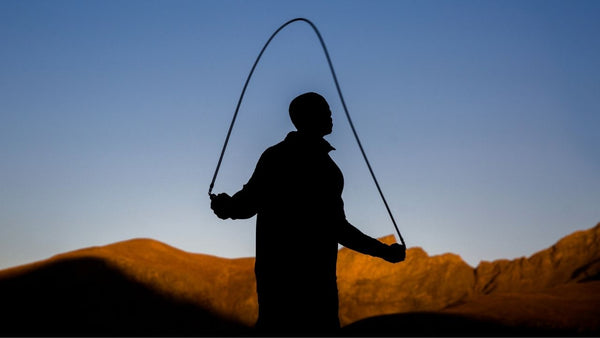You've seen what jump ropes can do. You know that it can help you burn fat, build endurance, and replace those long, nasty runs on pavement.
But you just can't seem to do it.
Every time you start, the rope ends up tripping up on your toes or whipping you across the shins. Then you try again. Same result. Lather, rinse, repeat.
We know the feeling. We've all been there at one point.
But while you may think you have no rhythm or coordination, it is very likely that you're making some of the most common mistakes we see every single day.
We wanted to know what the most common jump rope mistakes are, so we first polled our 88,000 members in our jump rope fitness community to see what they were struggling with the most.
Here's what we asked -

Let's dig into the four most common jump rope mistakes beginners make and finally break you through these barriers.
Jump Rope Mistake #1
The first common mistake beginners make is using a rope that is too light.
Light jump ropes - like the PVC ropes you can pick up at most department stores - are popular because they're cheap and well, they're just cheap.
But the problem with light ropes is they are very difficult to learn with.
They offer very little feedback which means you have absolutely no idea where the jump rope is while it's turning around your body. This makes it very tough to time your jumps.
How do you know if your rope is too light?
If you can turn it without much effort, it's light. If you can't feel where it is while you're jumping with it, it's too light.
Bonus: why use a heavy jump rope? We've got a infographic that breaks down the benefits of weighted jump ropes. Check it out!
Now, there's nothing wrong with light ropes. We use them (and even make our own). But for beginners, they can definitely be tricky to work with.
If you're using a light rope and you're tripping up a lot or you're getting frustrated, you need to give a weighted rope a try. (The type with the weight in the rope itself, NOT the handles. Weighted handles make it even more difficult to learn.)
THE QUICK FIX
We always suggest starting your journey with a heavier jump rope.
While it may sound counter-intuitive, a heavy rope will certainly give you enough feedback to be able to make adjustments as you're jumping. It will also slow down the rotation of your turn to allow you to really focus on timing your jumps right.
We've seen this over and over again.
Beginners often say they have no coordination or rhythm. But then they try the 1/2 LB jump rope (from our Get Lean Set) and they suddenly start stringing together jumps like it's nothing. It's kind of cool to watch.
The look in their eyes says it all. They instantly feel the difference.
What's a good heavy rope combo to start with? Check out our Get Fit Bundle.

Jump Rope Mistake #2
The second common mistake is excessive arm movement. This is actually common even among experienced jumpers.
It's common to see beginners turning the rope with their elbows or shoulders. This is not only inefficient, but it is also excessively fatiguing which can lead to a lot of frustrating mistakes.
How do you know if you're moving your arms too much?
Just watch yourself jump in the mirror or have a friend take a look at your form. Your arms should be mostly still and the majority of the movement should be coming from the wrists.
If you see elbows turning or, worse, shoulders rotating - stop.
Take a look at the following video. This is what your arms should look like while jumping. Notice how the elbows and shoulders use small, relaxed, natural movements while the wrists are the most active in rotating the rope.
THE QUICK FIX
As mentioned, the most efficient way to turn the rope is to use your wrists. To help you master this, we've got two quick videos for you to watch.
The first will show you a simple technique you can use (without the rope) to get a good feel for what good wrist rotation feels like. Watch that here:
The second video will show you where to position your hands to minimize frustration during jumping. Watch that here:
Jump Rope Mistake #3
The third common mistake we see is jumpers jumping too high.
Ironically enough, we see this with beginners who are afraid of making mistakes. They try to create as much space between themselves and the ground as they can.
We see beginners either bringing their knees up high or tucking their feet behind them all in an effort to give more time for the rope to pass underneath.
How do you know if you're making this mistake?
Again, watch yourself in the mirror or get a friend to watch or film you. For basic jumps, you should be only getting 1-2 inches off the ground (or less). Your knees should not be coming up and your feet should point slightly down.
Watch Dave's feet as he perform a basic jump here. Notice that he barely gets off the ground and his feet are kept close together at all times.
THE QUICK FIX
Here are a few guidelines to help you improve your bounding:
- Keep your feet together at all times
- Always land softly on the midsoles of your feet as this will allow you to rebound off the ground quickly
- Maintain a slight bend in your knees (nothing excessive)
- Practice jumping to a count to improve your rhythm
For a more in depth look, check out Dave's suggestions in the first part of this video:
Jump Rope Mistake #4
The fourth common mistake beginners make is maintaining a lack of confidence mentality.

If you have it in your head that jumping rope is 'too hard' and that you just don't have the rhythm or coordination to do it, you're only setting limits for yourself.
Sure - jumping rope is more challenging than elliptical trainer or stationary bike. You can't just jump on and start pedaling away.
With the jump rope, there's a bit of a learning curve, but a lot of benefit.
If you have the right attitude, tools and drills to work with, you will find it a lot easier than you ever thought. We guarantee it.
In fact, you may never want to use an elliptical trainer or stationary bike again!
THE QUICK FIX
You set your own limits.
Whether you think you can or think you can't, you are right.

What are you struggling with?
We hope this post has been helpful, but now we want to hear your story.
What are you struggling with? What is causing you the most frustration with the jump rope? Leave a comment below and let us know!
Bonus: if you’re interested in learning how to jump rope, we’ve got you covered. Check out our complete beginner’s guide to learning how to jump rope and get started today. Also check out our jump rope app for beginner friendly workouts.










